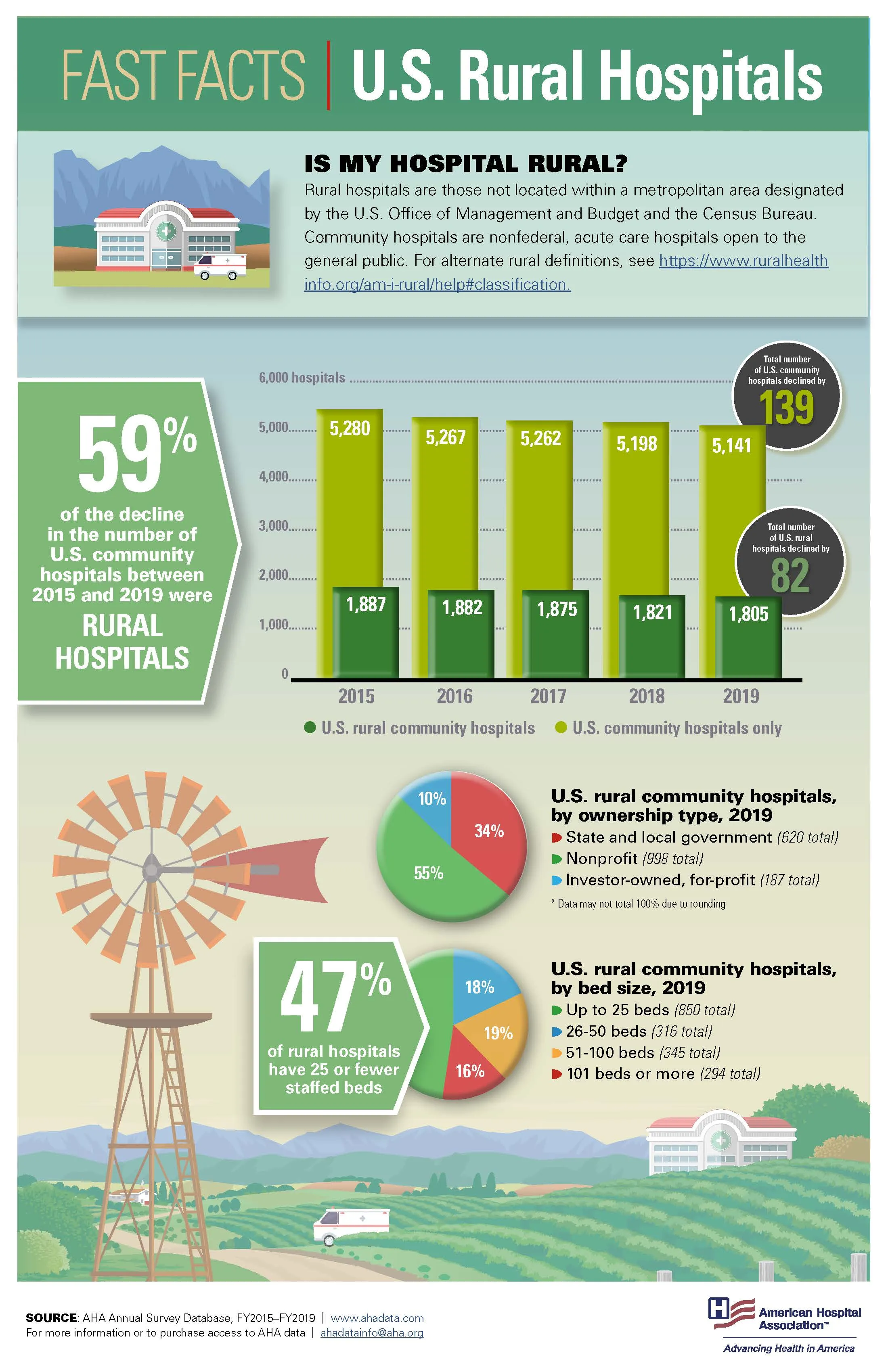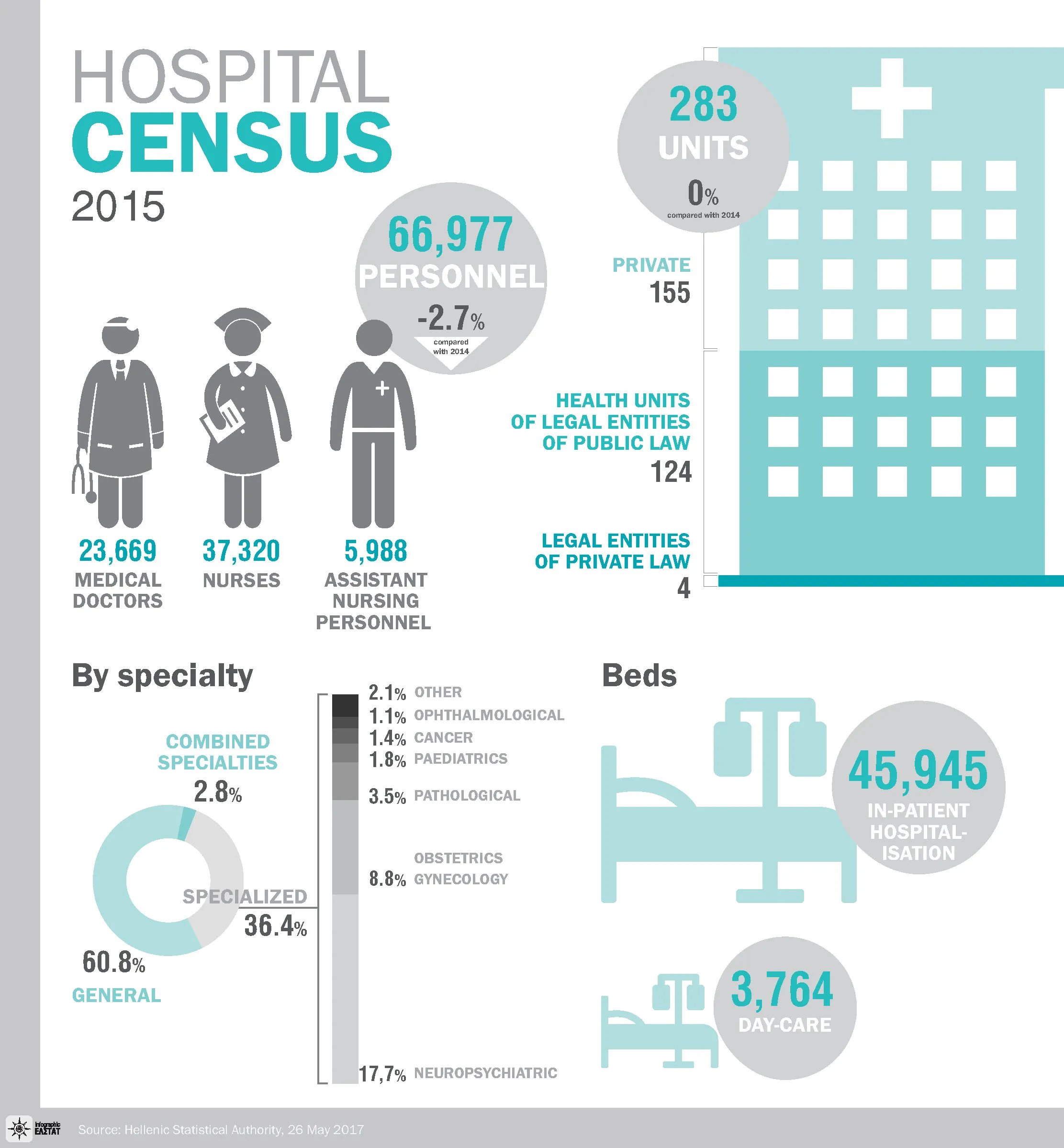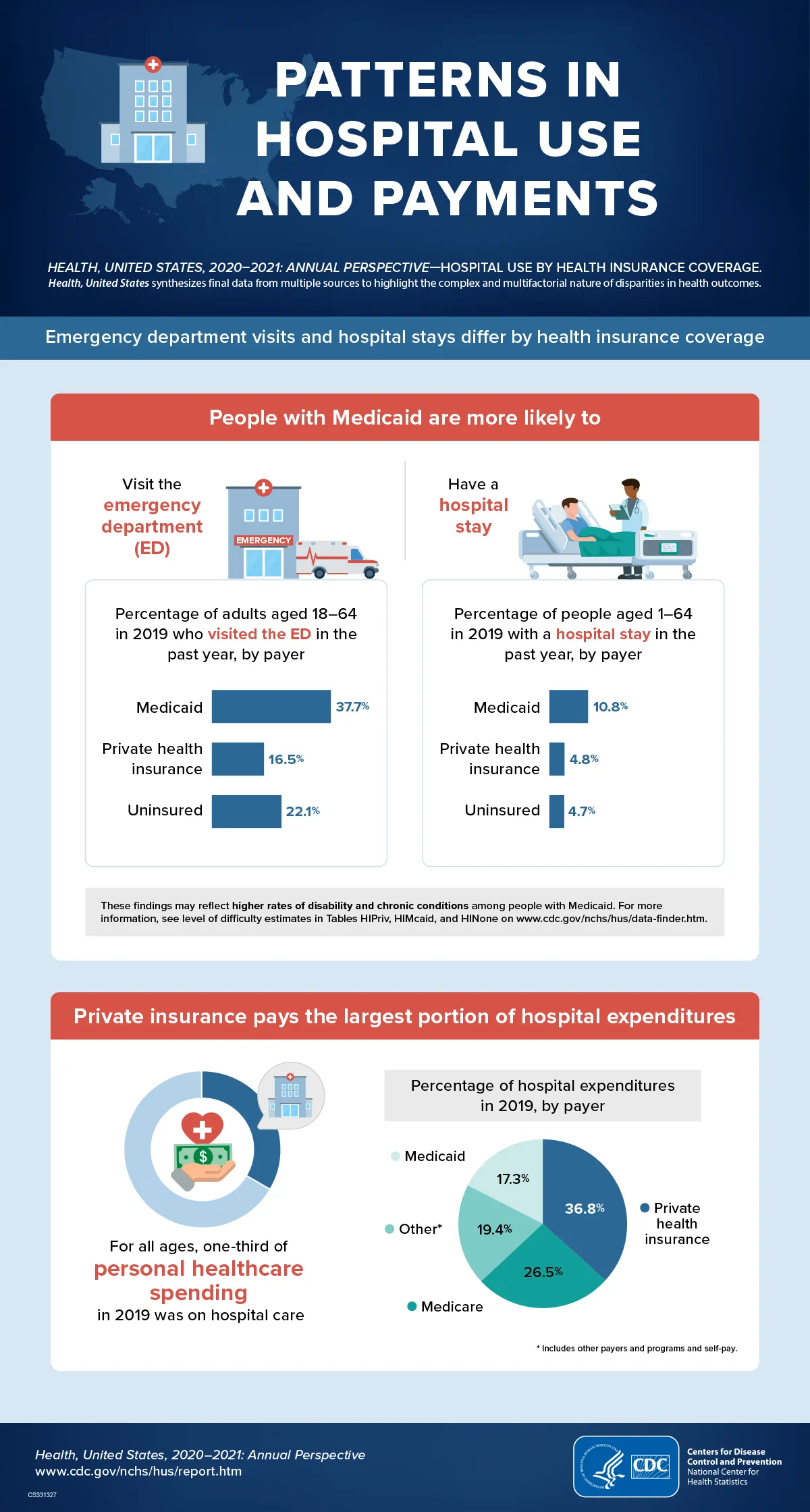85 Hospital Statistics & Facts: How Many Hospitals Are There?
As of 2021, there are approximately 6,090 hospitals in the United States and approximately 165,000 in the world.

Top 10 Hospital Statistics & Facts
- Approximately 36% of hospitals in the United States are non-profit organizations.
- In 2018, there were over 35 million hospital admissions in the United States, according to the American Hospital Association.
- The average length of a hospital stay in the United States is around 5 days.
- Hospitals in rural areas are more likely to close than those in urban areas, with over 100 rural hospitals closing since 2010.
- Medicare and Medicaid account for approximately 60% of all hospital reimbursements in the United States.
- Over 50% of all hospitals in the United States are part of a larger health system or network.
- The top three most common diagnoses for hospitalization are septicemia (sepsis), osteoarthritis, and liveborn infants.
- Hospital-acquired infections affect around 1.7 million patients each year, according to the Centers for Disease Control and Prevention (CDC).
- The annual cost of hospital readmissions in the United States is estimated to be around $17 billion.
- A study published by Health Affairs found that medical errors are responsible for between 210,000 and 440,000 deaths each year in U.S. hospitals.
How Many Hospitals Are There in the U.S?
- As of 2021, there are approximately 6,090 hospitals in the United States.
- Out of these hospitals, around 2,845 are non-profit organizations (46.7%), 1,234 are for-profit organizations (20.3%), and 1,623 are owned by state and local government entities (26.6%).
- California has the highest number of hospitals with over 400 hospitals followed by Texas with over 350 and Florida with over 200 hospitals.

How Many Hospitals Are There in the World?
- As of 2021, there are approximately 165,000 hospitals in the world.
- Asia has the highest number of hospitals with over 100,000 hospitals (60.6% of all hospitals in the world), followed by Europe with over 30,000 hospitals (18.2%) and North America with over 7,000 hospitals (4.2%).
- Africa has the lowest number of hospitals with only around 8,000 hospitals (4.8%).
- South America has around 15,000 hospitals (9.1%), while Oceania has around 3,500 hospitals (2.1%).
Hospital employment is on the rise
- Hospital employment is on the rise, with the healthcare industry projected to add 2.4 million new jobs by 2026, according to the Bureau of Labor Statistics.
- The healthcare sector has been a consistent source of job growth in recent years, accounting for over 16 million jobs in the United States.
- In 2018, hospitals employed over 5.7 million people, making it one of the largest employers in the country.
- Registered nurses (RNs) are among the most in-demand healthcare workers, with an expected job growth rate of 7% between 2019 and 2029.
- Healthcare support occupations, such as home health aides and medical assistants, are also expected to see significant job growth in the coming years.
Top Hospitals in the U.S
- Mayo Clinic (Rochester, MN) has been ranked as the #1 hospital overall by U.S. News & World Report for several years in a row.
- Cleveland Clinic (Cleveland, OH) is consistently ranked as one of the top hospitals in the country for cardiology and heart surgery.
- Massachusetts General Hospital (Boston, MA) is known for its expertise in cancer care and research.
- Johns Hopkins Hospital (Baltimore, MD) is renowned for its excellence in neurology and neurosurgery.
- New York-Presbyterian Hospital-Columbia and Cornell (New York City, NY) is consistently ranked as one of the best hospitals in the country for various specialties including psychiatry and rehabilitation.
- UCSF Medical Center (San Francisco, CA) is highly regarded for its expertise in diabetes and endocrinology.
- Brigham and Women's Hospital (Boston, MA) is known for its exceptional women's health services.
- Houston Methodist Hospital (Houston, TX) has been recognized as one of the best hospitals in Texas with high-performing specialties such as gastroenterology & GI surgery.
- Duke University Hospital (Durham, NC) has been recognized as one of the best hospitals in North Carolina with high-performing specialties such as pulmonology & lung surgery.
- Northwestern Memorial Hospital (Chicago, IL) has been recognized as one of the best hospitals in Illinois with high-performing specialties such as orthopedics.
Hospitals are the second largest employer in the United States
There are over 5,000 registered hospitals in the United States, making them the second largest employer in the country.
Hospital costs are rising faster than inflation
- Hospital costs have been rising faster than inflation for several years, with an average annual increase of 4.4% between 2013 and 2018, according to the Health Care Cost Institute.
- In 2018, the average cost of a hospital stay in the United States was over $15,000.
- The cost of healthcare services is projected to continue to rise in the coming years, with estimates suggesting that national health expenditures will reach nearly $6 trillion by 2027.
- A study published in JAMA Network Open found that hospital prices for privately insured patients increased by more than double the rate of inflation between 2007 and 2014.
- Out-of-pocket expenses for hospitalized patients have also been increasing, with a study from JAMA Internal Medicine finding that deductibles for employer-sponsored health insurance plans rose by nearly 300% between 2006 and 2015.

Rural hospitals are closing at an alarming rate
- Since 2010, over 100 rural hospitals have closed in the United States.
- According to the National Rural Health Association, more than 450 rural hospitals in the United States are at risk of closure.
- In states that did not expand Medicaid under the Affordable Care Act, rural hospital closures have been particularly severe, with a 76% increase in closures between 2010 and 2020.
- Since 2010, 136 rural hospitals have closed across the United States. This trend is expected to continue, with as many as 25% of rural hospitals at high risk of closure.
The United States spends the most on healthcare
- The United States spends more on healthcare than any other country in the world, with healthcare expenditures accounting for 17.7% of GDP in 2019.
- In 2018, total healthcare spending in the United States reached $3.6 trillion, or $11,172 per person.
- Healthcare spending is projected to continue to rise in the coming years, with estimates suggesting that it will reach nearly $6 trillion by 2027.
- The United States spends more on healthcare than any other country in the world. In 2019, the United States spent $3.8 trillion on healthcare.
Hospital-acquired infections are a major problem
- Approximately 1 in 31 hospitalized patients will develop a hospital-acquired infection, according to the Centers for Disease Control and Prevention (CDC).
- Hospital-acquired infections affect around 2 million patients each year in the United States.
- The most common types of hospital-acquired infections include urinary tract infections, surgical site infections, bloodstream infections, and pneumonia.
- It is estimated that hospital-acquired infections cost the U.S. healthcare system between $28 billion and $45 billion each year.
Medical errors are a leading cause of death
- Medical errors are responsible for a significant number of deaths in the United States, with estimates ranging from 210,000 to 440,000 deaths each year.
- According to a study published in the Journal of Patient Safety, medical errors may be the third leading cause of death in the United States after heart disease and cancer.
- Medication errors alone are estimated to cause at least one death every day and injure approximately 1.3 million people annually.
- Diagnostic errors are also a major problem, with an estimated 12 million adults in the United States experiencing a diagnostic error each year.
- Surgical errors can be devastating, with studies suggesting that up to 4,000 surgical mistakes occur each year in the United States.
Hospitals are adopting new technology
Hospitals are increasingly adopting new technology to improve patient outcomes and reduce costs. In 2018, 76% of hospitals had adopted at least a basic electronic health record system.
The demand for healthcare workers is increasing
- According to the Bureau of Labor Statistics, the healthcare industry is projected to add 2.4 million new jobs by 2026.
- This represents a growth rate of 14%, which is much faster than the average for all occupations in the United States.
- Among these new jobs, home health aides and personal care aides are expected to see the largest increase in employment, with a projected growth rate of 34% and 41%, respectively.
- Registered nurses (RNs) are also in high demand, with an expected job growth rate of 7% between 2019 and 2029.
- Other healthcare occupations that are expected to see significant job growth include physician assistants (31%), medical assistants (19%), and physical therapists (18%).

Hospitals are Going Green: Sustainable Practices on the Rise
Hospitals are adopting sustainable practices to reduce their environmental impact. In 2018, 70% of hospitals reported having a sustainability program in place.
The Percentage of Uninsured Patients Treated by Hospitals
- In 2018, approximately 27.5 million individuals in the United States were uninsured, according to the U.S. Census Bureau.
- According to data from the American Hospital Association, around 5% of hospital admissions in the United States are for uninsured patients.
- In some states with high rates of uninsured residents, such as Texas and Florida, the percentage of hospital admissions for uninsured patients can be as high as 10% or more.
- Treating uninsured patients can be costly for hospitals, and they may have to write off these costs as uncompensated care. In 2018, uncompensated care costs totaled over $41 billion in the United States.
Hospital Statistics & Facts
Hospital Patient Demographics
- In 2018, there were over 36 million hospital admissions in the United States.
- The average length of a hospital stay is 4.6 days.
- The most common reason for hospital admission is childbirth.
- Men are more likely to be hospitalized than women.
Hospital Finances
- In 2019, the top 5% of hospitals accounted for 50% of all U.S. hospital spending.
- The average hospital profit margin is 3.5%.
- Hospitals with higher nurse staffing levels have lower rates of patient mortality.
Hospital Quality & Safety
- Hospital quality ratings can be found on the Centers for Medicare & Medicaid Services (CMS) Hospital Compare website.
- Hospitals with higher nurse staffing levels have lower rates of patient falls.
- The most common hospital-acquired infections are urinary tract infections and surgical site infections.
Hospital Technology
- In 2018, 96% of hospitals had an electronic health record system with clinical notes.
- Hospitals are increasingly using telemedicine to provide remote care to patients.
- Artificial intelligence is being used to improve diagnostic accuracy and patient outcomes.

Hospital Workforce
- The average age of a registered nurse is 47 years old.
- In 2018, there were over 3 million registered nurses in the United States.
- The unemployment rate for healthcare practitioners and technical occupations is 2.3%.
Hospital Sustainability
- Hospitals are reducing waste by reprocessing medical devices.
- Energy-efficient lighting can save hospitals up to 75% on lighting costs.
- Hospitals are reducing their water usage through the use of low-flow fixtures.
FAQs
How are hospitals funded?
Hospitals in the United States are funded through a combination of sources, including private insurance, Medicare and Medicaid, and out-of-pocket payments from patients. Non-profit hospitals may receive tax-exempt status, which allows them to save on certain taxes.
What is the difference between non-profit and for-profit hospitals?
Non-profit hospitals are exempt from paying certain taxes because they are considered charitable organizations. Any profits made by non-profit hospitals must be reinvested into the hospital or used for charitable purposes. For-profit hospitals, on the other hand, are owned by investors who expect a return on their investment.
How do I choose a hospital?
When choosing a hospital, it's important to consider factors such as the hospital's quality ratings, patient satisfaction ratings, and proximity to your home. You can find information about hospital quality ratings on the Centers for Medicare & Medicaid Services (CMS) Hospital Compare website.
What should I bring with me to the hospital?
When going to the hospital for an appointment or procedure, it's important to bring your insurance card, a list of any medications you're currently taking, and any medical records related to your condition. You may also want to bring comfortable clothing and personal items such as books or magazines to help pass the time during your stay.
What is telemedicine?
Telemedicine refers to healthcare services that are provided remotely using technology such as video conferencing or remote monitoring devices. Telemedicine can be used for routine appointments as well as consultations with specialists who may not be located in your area.
What is artificial intelligence (AI)?
Artificial intelligence refers to computer systems that can perform tasks that normally require human intelligence. In healthcare settings, AI is being used to improve diagnostic accuracy and patient outcomes by analyzing large amounts of data and identifying patterns that may be difficult for humans to detect.
How can I help reduce my risk of developing a hospital-acquired infection?
To help reduce your risk of developing a hospital-acquired infection, it's important to practice good hand hygiene by washing your hands frequently and using hand sanitizer. You should also avoid touching your face, especially your mouth and nose, and follow any infection prevention guidelines provided by the hospital staff.
The most common surgeries performed in hospitals
Surgeries are a common medical intervention that many patients undergo each year. Here are some of the most common surgeries performed in hospitals:
- Cesarean section: A cesarean section, or C-section, is a surgical procedure used to deliver a baby through an incision made in the mother's abdomen and uterus. According to the CDC, approximately 1 in 3 births in the United States is delivered by C-section.
- Knee replacement: Knee replacement surgery is a procedure used to replace a damaged or worn-out knee joint with an artificial joint. This surgery is typically done on patients with severe arthritis or other knee-related conditions.
- Gallbladder removal: The gallbladder is a small organ located near the liver that helps digest fat. When it becomes inflamed or develops stones, it may need to be removed surgically. This procedure, called a cholecystectomy, is one of the most common abdominal surgeries performed in the United States.
- Hernia repair: A hernia occurs when an organ or tissue protrudes through a weak spot in the surrounding muscle or connective tissue. Surgery is often required to repair these types of hernias.
- Hysterectomy: A hysterectomy is a surgical procedure used to remove all or part of a woman's uterus. It may be done for medical reasons such as cancer, fibroids, or heavy bleeding.
These are just some of the many types of surgeries performed in hospitals each year. If you're scheduled for surgery, your healthcare provider can provide more information about what to expect before and after your procedure.
Conclusion
Overall, hospitals play a critical role in our healthcare system. By understanding these hospital statistics and facts, we can work to improve the quality, safety, and sustainability of our healthcare system.
Sources
- https://www.ahadata.com/aha-hospital-statistics
- https://www.aha.org/infographics/2021-05-24-fast-facts-us-rural-hospitals-infographic
- https://www.statista.com/topics/1074/hospitals/
- https://www.chausa.org/about/about/facts-statistics
- https://www.who.int/data/gho/indicator-metadata-registry/imr-details/3361
Contact us
North Carolina, Nevada, Utah, Virginia
New Hampshire, Maine
Arizona, Colorado, Georgia, New Mexico, Oklahoma, Texas
.avif)

